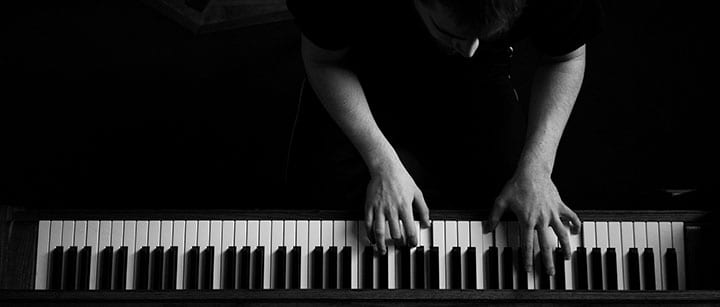Don’t forget about piano arpeggios when you sit down to practice! Here, Helendale, CA teacher Sylvia S. shares her tips for playing and practicing them…
One of the great masters of 20th century piano showmanship was Liberace, otherwise known as the Elvis of piano performance. Liberace’s trademarks were wildly ostentatious outfits, candelabras atop the piano, and dramatic, finger-tangling sweeps across the keyboard of a grand piano. Those dramatic sweeps, known as arpeggios, are available to any aspiring pianist who has the patience to learn the art.
Arpeggios are also an amazing way to create sound effects on a piano. The rapid tinkling of pianissimo major seventh arpeggios in the high notes can sound angelic, like tiny drops of the first rain in spring that evoke the image of an impressionist painting.
Mysterious and dark, a slow forte diminished arpeggio in the base notes has a familiar yet foreboding sound, like the soundtrack to suspenseful parts of a scary movie. The full range of arpeggio sounds can produce a practically unlimited combination of effects… no synthesizer required!
An arpeggio is just a chord played one note at a time, like a piano scale – and there is a seemingly endless number of arpeggio piano arrangements out there! Piano arpeggio patterns are used to create a fast and flowing sound, helping to add speed to playing as well as to improve your improvisation skills.
Are you ready to learn more about this fun piano effect? Whether you’re teaching yourself how to play piano or taking lessons, arpeggios aren’t too challenging to master. Let’s dive in!
How Many Piano Arpeggios Are There?
It is estimated that there are more than 6000 different arpeggios to practice when they are performed with just four basic patterns:
- Right hand legato, left hand staccato
- Both hands staccato
- Left hand legato, right hand staccato
- Both hands legato
Some major piano arpeggios to master include:
- C: C, E, G, C
- C#/Db: C#, F, G#, C# / Db, F, Ab, Db
- D: D, F#, A, D
- D#/Eb: D#, F##, A#, D# / Eb, G, Bb, Eb
- E: E, G#, B, E
- F: F, A, C, F
- F#/Gb: F#, A#, C#, F# / Gb, Bb, Db, Gb
- G: G, B, D, G
- G#/Ab: G#, B#, D#, G# / Ab, C, Eb, Ab
- A: A, C#, E, A
- A#/Bb: A#, C##, E#, A# / Bb, D, F, Bb
- B: B, D#, F#, B
Here is a video on YouTube that will show you some more information about piano improvisation exercises you can do to become a better player:
What is the Arpeggio Pattern?
An arpeggio is a series of three or four notes played, one after another, that sound good together. Learning how to play arpeggios is one of the first steps for understanding the science of how to create beautiful harmonies on the piano keyboard. Playing piano arpeggios well is an art as well as a science.
One-octave arpeggios come in many different styles and flavors, and all of them are based on chords. The most common are three- and four-note arpeggios. Three-note arpeggios are a great place for beginning students to start. These are:
- Major
- Augmented
- Minor
- Diminished
Perhaps the simplest example is the C Major arpeggio piano chord, which contains the notes C, E, and G, played both forward and backward: C-E-G-E-C. Start with the right hand, using fingers 1-3-5-3-1 (finger number 1 is the thumb), and using the fingers 5-3-1-3-5 with the left hand. After you can do this with both hands separately, try playing both hands together. This will be a little tricky, so remember when one hand is using finger 5, the other hand will use the thumb (finger 1 ).
Four-note arpeggios are a little more complicated. These are for intermediate students, so if you’re new to piano just skip over these for now. These are the most common versions of four-note arpeggios:
- Major with Major seventh
- Major with minor seventh (also known as “Dominant”)
- Augmented with minor seventh
- Minor with minor seventh (also known as “minor seventh”)
- Diminished with minor seventh (also known as “half-diminished”)
- Diminished with double-flatted seventh (also known as “full-diminished” or just “diminished”)
How Do You Play Arpeggios on Piano?
Do you want to know how to play arpeggios? Piano players of all kinds will benefit from learning how to play these “broken chords,” which can be played in both ascending and descending order.
Here are some tips to introduce you to piano arpeggios.
- When you’re ready, learn how to play every type of arpeggio in every key. Yes, all 12 keys, and all 10 types. Don’t expect to practice everything in one sitting. Maybe you’ll have more fun learning all the arpeggio types in one key before moving on to the next key. Or maybe there’s a certain sound effect that you’d like to check out in all the keys. However you want to learn, be consistent and keep moving forward each time you are at the piano keyboard.
- After you’ve mastered one-octave arpeggios, you’re ready for the piano big leagues. Soon you’ll be taking on the entire keyboard like a pro. Here’s the good news: if you can master the second octave, running the length of a seven-octave piano should be a piece of cake.
Next…
- Relax your shoulders and wrists, working with your hands as your thumb and fingers move in a constantly-flowing, over-and-under wave motion. Let your elbows move in and out, going with the flow as your hands rotate gently over the keys. Keep your back straight, and allow yourself to bend side-to-side at the waist if you’re traveling over the keyboard, keeping your shoulders aligned parallel to the floor. If you do it right, you’ll get a great upper-body workout at the same time!
- Start slowly, using a metronome, and then build up speed as you get more comfortable. That way, you’re more likely to sound like the smooth and suave musician you are, and not like Peter Cottontail thumpity-thump-thumping down the bunny trail. (For more about working with a metronome, read my post “8 Simple Steps for Learning Fast Piano Songs”)
- Be prepared. After your posture and position are comfortable, the best preparation for pianistic takeover is fingering. Unlike the one-octave arpeggio, your thumb and fourth finger (both hands) will be constantly moving over (fingers) and under (thumb) each other. Be ready to make a move before you’ve reached your third or fourth finger. Word of advice: Don’t wait until you’ve played the fifth (pinkie) finger or you’ll get stuck. You’ll either be tripping over your fingers, or trying to rotate your wrist over to play with the back of your hands. Just don’t do it.
Extra Tips: Tuck the thumb under to play the natural keys, while the fingers are reaching up to play the sharps and flats. Decide what fingers you want to use, and practice the same fingering each time. After you get the hang of them, arpeggios are a great way to warm up your hands before practicing music, just like a sports team warms up before practice.
What is the Difference Between Scales and Arpeggios on Piano?
Scales and arpeggios are commonly confused.
However, the main difference between scales and arpeggios piano players need to know is that with scales, you are moving from one note to the next.
In an arpeggio, you will be jumping over the notes. Which ones should you learn first?
Try to start by mastering piano scales first. C major is a great place to start. Then, you can move on to mastering piano arpeggios, which can be a bit more challenging.
What is the Best Way to Learn Piano Arpeggios?
Are you interested in learning piano arpeggios? You can always teach yourself, but one of the best ways to master this technique is to take piano lessons with a qualified instructor.
Of course, there’s nothing wrong with shaking things up a bit as you practice during the day-to-day, either. Maybe you want to venture beyond 10 types of piano arpeggios in 12 keys over seven octaves (that’s 840 octaves and 120 arpeggios).
Okay, maybe not… but what if you seek additional intellectual stimulation with your warm-up?
Try arpeggios in contrary motion; starting with one center note, each hand moves outward from center, and then back. Give it a whirl, it’s a mind-bender. Or, if harmony is your desire, try a different arpeggio in each hand (like c minor seventh with E♭major seventh) The possibilities are endless…
If you’ve followed these simple directions and still feel like a beginner, you’re not alone. Most pianists take many years learning how to play arpeggios with finesse.
So, when you’ve reached the conclusion of your arpeggio, whether it’s a simple, three-note glide within a single octave or a fortissimo multi-octave, mind-boggling, finger-tangling adventure, go ahead and finish it with confidence.
Use that well-rested fifth (pinkie) finger or, if you prefer, finish up with your choice of any dramatic flourish, fingering, or hand motions. Why not? You’ve worked hard for it.
You, too, deserve a Liberace moment.
 Sylvia S. teaches singing, piano, theater acting, and more in Helendale, CA. She comes from a musical family of several generations, and her experience includes playing an electric keyboard and singing vocals in a professional, working band. Learn more about Sylvia here!
Sylvia S. teaches singing, piano, theater acting, and more in Helendale, CA. She comes from a musical family of several generations, and her experience includes playing an electric keyboard and singing vocals in a professional, working band. Learn more about Sylvia here!
Photo by RobertJinks
Suzy S.







